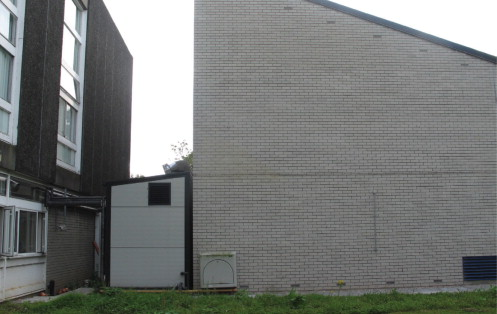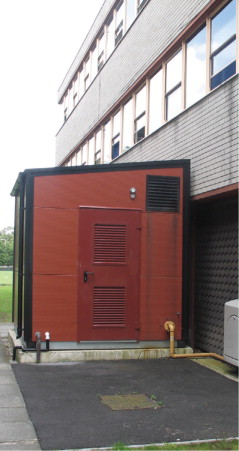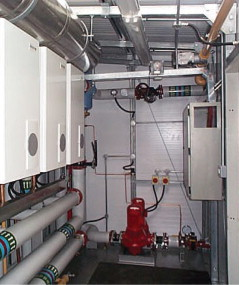


Offsite manufacture enabled the new Lancashire Constabulary plant system to be installed within an extremely tight timescale, which would have otherwise meant site occupants being without heating and hot water in the winter months.
Lancashire Constabulary has responsibility for 220 buildings, including police stations and operational centres with an annual energy bill approaching £500,000/year. The system for supply of heating and hot water at one of its largest sites, the Hutton Hall Police Training Centre, in Preston, Lancashire, was in urgent need of replacement. The centralised oil-fired boiler, with two calorifiers for hot water supply, had ceased to manage the site's demand effectively for some years, requiring the installation of new heating systems for the accommodation blocks.
In 2006, it became necessary to install replacement systems for the remaining buildings at the site, including a sports hall, administrative centre, firing range, dining room and teaching block. The existing system was inefficient, with extensive distribution losses, and engineers advised the Constabulary that the boiler could not meet the needs of the site over the coming winter.
Project priorities
Lancashire Constabulary had a number of priorities. As the site is financed from public funds it was important to reduce the energy costs as much as possible. The energy manager, Ed Palmer, who has developed the Constabulary's sustainability policy, also wanted to capitalise on the opportunity to improve the energy efficiency and carbon footprint for the estate, and to position the site to meet increasingly stringent environmental legislation. A key part of this strategy involved a move away from oil towards a gas-fired system with reduced carbon impact.
The nature of the operations at Hutton Hall also had an impact on the choice of equipment. The site houses several buildings with 24/7 demand, such as call centres on 24-hour duty, and the National Police Computer Database HQ.
The timescale was such that, once the capital investment was approved, there was insufficient time to carry out the installation using traditional onsite methods before the onset of the colder weather. Several weeks were required for groundworks to install gas pipes, so that traditional onsite installation of the boiler house could not begin until October. An alternative solution was sought that would ensure continuity of supply of hot water and heating for the site's occupants.
Careful pump control
Ed Palmer carried out a feasibility study comparing three alternative approaches. The solution which proved to be the most effective was the installation of four offsite constructed packaged plant rooms, incorporating highly-efficient variable speed systems based around the Armstrong MBS integrated heating solution, controlling the company's IVS pumps and pressurisation equipment.
The MBS incorporates fully modulating boilers, variable primary pumps, automatic fill/pressurisation unit and integrated controls, all pre-specified for optimum efficiency and pre-assembled for rapid installation on site. It enables excellent boiler efficiencies to be achieved without time-consuming mixing and matching of system components.
Instead of treating the condensing boiler in isolation, the MBS matches pumps, controls and hydraulic system design. This ensures compatibility of components and enables specifiers to meet and exceed the boiler efficiency levels required under the new Part L of the Building Regulations with energy-efficient, low carbon performance designed into the system as standard.
Part L2 calls for minimum overall boiler efficiencies of 84% in new build and 80% in existing buildings. The MBS can achieve overall seasonal efficiencies of 94%, providing significant energy savings and carbon reductions throughout the lifetime of the plant. As the system is fully integrated and pre-assembled, additional system design input is not necessary, and installation and commissioning can be achieved much more easily and quickly.
Equipment installation
The plant equipment that has been installed is as follows:Plant room one
• Enclosure size: 3000 × 2500 × 3000
• Total output: 160 kW LTHW and 49 kW 368 litre storage hot water.
• The system components include the MBS integrated heating solution incorporating two Armstrong 80 fully modulated gas-fired condensing boilers and 1 Boss BUF 100 – 199 Condensing gas-fired gas water heater. Armstrong also supplied its 4392 series Startwin 50 – 200 0.55 kW pumps and the Autofill pressurisation unit.
Plant rooms two, three and four have broadly similar equipment installed, though the number of boilers varies, as do the pump ratings, Startwin 80 – 200 1.5 kW and 80 – 160 1.1 kW units being used instead. Enclosure sizes vary a little, and total outputs are 160, 240 and 320 kW, the latter for plant rooms two and three.
The pumps are suitable for LTHW, MTHW, chilled and condenser water, and feature an all bronze construction for secondary hot water/DWHS installations. The range features a DIN 24960 mechanical seal with carbon-silicon carbide faces for long life. They are trimmed to suit specified duties, to ensure efficient performance and optimal motor selection. The solid stainless steel shaft resists corrosion and is claimed to reduce possible leakage.
Cost savings
One year on, analysis has shown that the site's energy requirement has been reduced from the equivalent of 4,503,600 kWh/year to 2,550,730 kWh/year – a saving of 1,952,870 kWh. This reduction, calculated at a cost of 6.5 p/kWh (oil) equates to an annual saving of nearly £127,000.
As the site has moved away from an oil-fired boiler in favour of highly efficient condensing boilers, there are further reductions in energy costs arising from the prices differences between gas and oil. Calculated based on a gas price of 1.8 p/kWh and an oil price of 6.5 p/kWh, the cost saving as a result of change of fuel is £118,700. This means that the total cost saving amounts to over £245,600 each year. It is estimated that the four packaged plant rooms have paid for themselves in one year.
Environmental improvements
The environmental benefits have also bee considerable. Calculated at a rate of 0.27 kg CO2/kW, the move to the new system has reduced carbon emissions by 525.27 tonnes/year. As the plant rooms use gas for heating instead of oil, there is a further reduction in carbon emissions resulting from the change of fuel of 217 tonnes of CO2/year. This amounts to an overall reduction in CO2 emissions of 744 tonnes each year.
Streamlining the project
Constructing the packaged plant rooms off site also had project benefits. The packaged plant rooms were assembled concurrently with the excavations for the gas pipes rather than commencing once this work was completed. This significantly shortened the timescales. The plant rooms were delivered to site, fully assembled, requiring only final connections.
By completing the project by the target date, it was possible to guarantee continuity of supply of hot water and heating for site occupants. Traditional onsite methods of plant room construction could not have met the target date and would have continued into the winter months. In addition, manufacturing the plant rooms in a purpose-designed factory reduced the health and safety risks associated with the project. Contractor presence and traffic at the site was also reduced.
Ed Palmer, Energy Manager for Lancashire Constabulary commented: “It was only when we analysed the energy consumption at the end of the first year, that we realised just how much money the packaged plant rooms had saved the taxpayer. The equipment has paid for itself in just a year, and will continue to deliver cost savings throughout its life.”




